The 2015 MacBook Review
by Ryan Smith on April 14, 2015 10:15 AM ESTWindows Performance
Shifting gears from OS X, let’s take a look at performance under Windows. Though not every MacBook will be used with Windows, Windows gives us a wider selection of benchmarks to work with, and it gives us a chance to compare the MacBook to some contemporary PCs.
For our Windows comparison I’ve pulled in a number of results from our most recent Core M review, including other Core M laptops, the Haswell-U powered Surface Pro 3, and a couple of Broadwell-U powered laptops. Of particular interest is likely the Asus UX305, which is another Core M based laptop that uses a very similar build. At 13.3” it’s larger than the MacBook, but it is a similar aluminum fanless design.


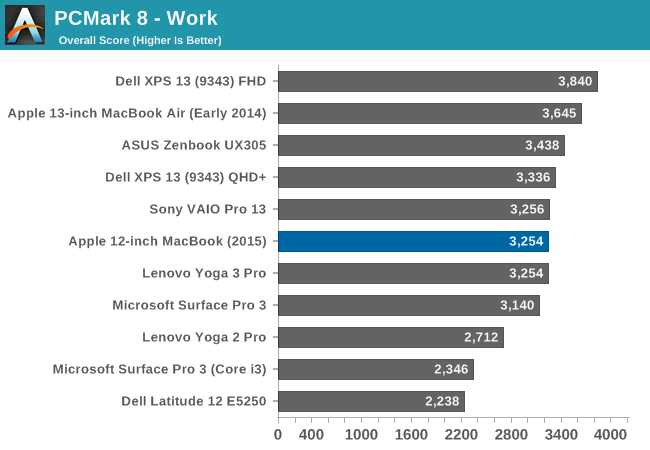
Depending on which sub-test we’re looking at, the PCMark workloads are a mix of bursty workloads, lightly threaded workloads, and heavily threaded workloads. As a result the MacBook and its Core M processor are given some opportunity to show off, and at other times is pushed back due to its cap on sustained performance.
The Home workload is one such light test, which plays into the MacBook’s favor. Here it’s towards the top of the charts, surpassing everything other than the Core M based Asus UX305, and then the more powerful Broadwell-U based Dell XPS 13s. I keep rattling on about workload types and this is a good example of why it matters, because in a light workload the MacBook is among the fastest of the ultra-portables, beating out many other Core M devices and also some Haswell based Ultrabooks. Put another way, in a light workload Core M can already deliver (and at times exceed) one-generation old Haswell Ultrabooks.
As for the Creative and Work workloads, the MacBook still places relatively well. Doing this well on the Creative workload was a bit of a surprise, since it’s the most demanding benchmark of the 3. I suspect we may be seeing a mix of dividends from the SSD and Core M’s GPU, Otherwise the lighter Work test actually has the MacBook farther behind the pack, with performance in-line with other Core M laptops, though not as exciting compared to the Ultrabooks.
Overall, between our OS X and Windows CPU benchmarks, what we’re finding is that the performance of the MacBook generally mirrors our expectations given what we know about its design and component selection. Given a light workload that allows the Core M CPU inside of the MacBook to turbo to its fastest speeds, it’s a very potent competitor in a small package, able to give all but the most recent Ultrabooks a run for their money. However heavier, sustained workloads drive a wider gap in between the two classes of devices, and in those cases the MacBook offers performance closer to Ultrabooks a 3-4 years old.
Shifting gears one more time, let’s take a look at GPU performance. GPU workloads present an interesting scenario for Core M, and by extension the MacBook. The underlying Intel HD Graphics 5300 GPU is a GT2 configuration, making it moderately powerful for an iGPU, however the power and thermal constrains on the MacBook means that the laptop doesn’t have the power required to run a GT2 GPU at full speed.
With the Broadwell CPU cores alone able to chew up 4.5W and then-some, a combined GPU+CPU workload will generally put the MacBook in a pinch. Consequently I don’t see the MacBook being used as any kind of gaming machine – the MacBook Air is undoubtedly a much stronger contender – but it’s useful to put this performance in context.
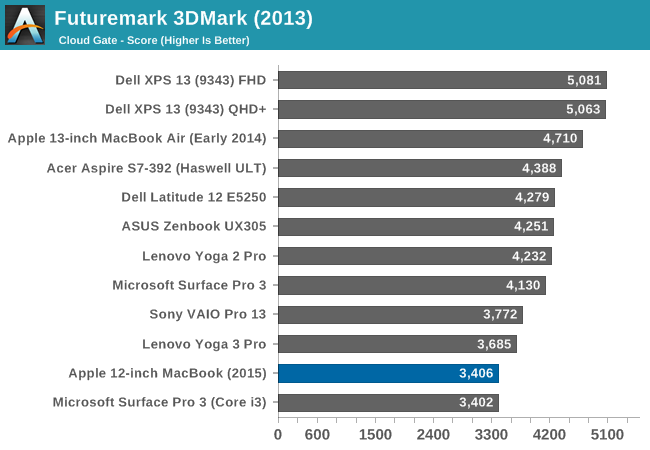
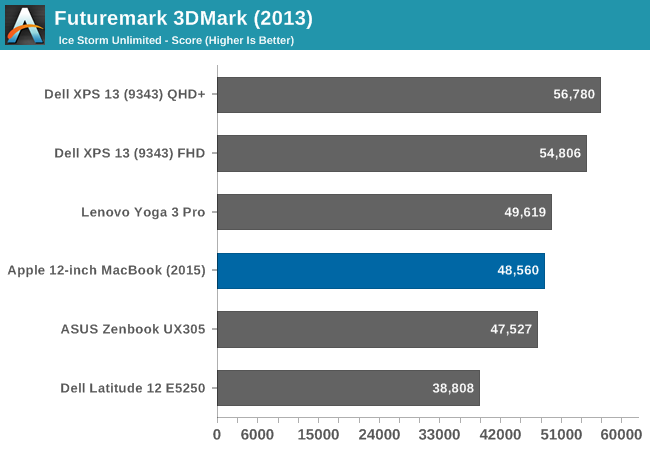
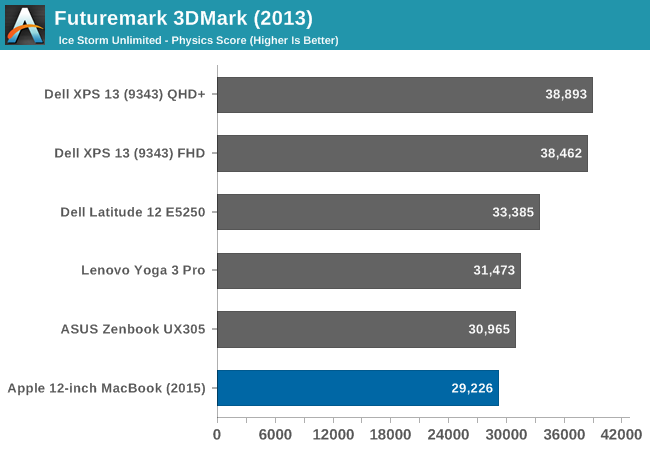
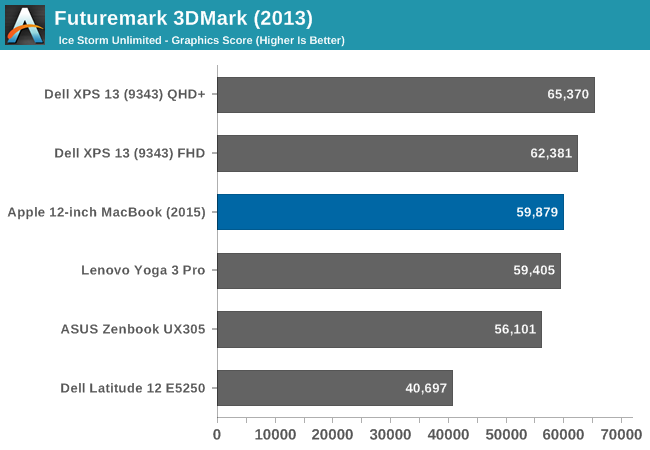
Our 3DMark scores handily illustrate this exact point. Facing significant power and thermal limits, the MacBook has to pull back in performance and consequently ends up near the bottom of our charts, versus its much better showing in PCMark. The 2014 MacBook Air 13” is some 38% faster at Cloud Gate, and on the newer Ice Storm benchmark the results aren’t much better. Of the two it’s worth noting that Cloud Gate is a much more complex and longer running benchmark, whereas Ice Storm is a quick running tablet-sized benchmark. Consequently Cloud Gate throttles harder and sooner, which is why the MacBook does relatively worse there. Overall the MacBook doesn’t even beat any of the other Core M laptops, which is a bit surprising. But nothing here is quite like the MacBook, so it’s somewhat different in its combination of small size and aluminum chassis.
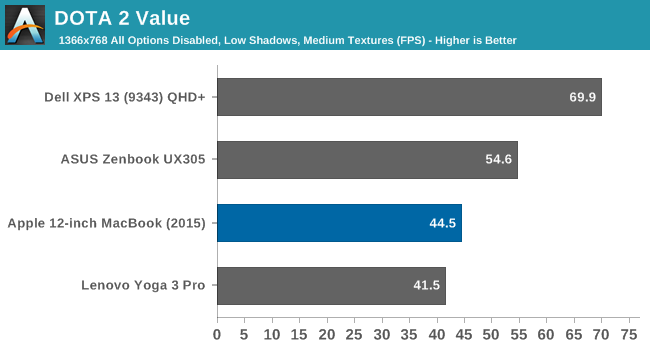
Meanwhile I have also run our DOTA 2 Value benchmark against our other Core M devices and the Broadwell-U based Dell XPS 13 for good measure. On an absolute basis 44.5fps is definitely playable for a game like DOTA, however on a relative basis this is a weaker showing than the UX305, not to mention the XPS 13. Compared to the UX305 the MacBook again appears to be throttling sooner and harder, whereas the Ultrabook-sized XPS takes full advantage of its higher power limits and better cooling.
Ultimately as we said when opening up our look at GPU performance, the MacBook’s GPU is potent on paper, but it simply doesn’t have the power and cooling capabilities needed to take full advantage of it. This means that while CPU performance isn’t too far removed from the Ultrabooks, GPU performance absolutely is.
Finally, I wanted to take one last look at performance relative to the tablets, this time from a GPU perspective.
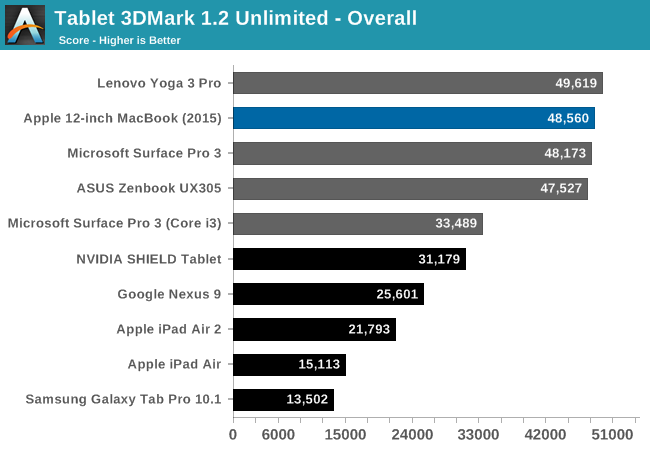
While the iPad Air 2 makes a good run on the MacBook in the web benchmarks, it and the other tablets are even more power limited than the MacBook, and as a result their GPU performance is even more constrained. The MacBook still has a better than 2x lead on the iPad Air 2 in this GPU benchmark, so judging from this it will be some time yet until an iPad's GPU performance catches up with this MacBook's.










354 Comments
View All Comments
xchaotic - Monday, April 20, 2015 - link
They won't let you do that due to planned obscolesnce by both Apple and Intel. 16GB RAM and 1TB SSDs will be the max for quite some time.shompa - Friday, April 24, 2015 - link
One point about Intel/ARM. Intel Core-M 82mm2 1,3 billion transistors. Cost about 280 dollars + you have to buy Intel motherboard chips. Apple A8X is 132mm2 3 billion transistors. It cost Apple about 20 dollar to manufacture that. (on the market 130mm2 ARM SoCs cost about 50 dollars unsubsidized). When will the techpress and IT experts point this out? How can something that cost Intel 50% less than A8X cost the customer 20times more?The Macbook have an insane price but Intel is at least 400 dollar of that problem.
This is why we need to move away from X86 to ARM. (and Apple will move to ARM because they controll the OS/Hardware = they can add anything they want into the SoC. Huge parts of the A class SoCs are Apple specific stuff like Siris DSP, the visual processor, security enclave/TouchID and so on. About 30% of die area today. Imagine if Microsoft started to do custom ARMs/(or AMD X86) for their Windows. That would add value to the customer and make people buy MSFT hardware because they want to (not because they are forced to, like today with their OS)
One of the main problem is "capitalism". A good (older) company have 10-12% profit on what they sell. Simple math: 10% on a 500dollar intel is more than 10% on a 25 dollar ARM.
Intel is however a monopoly today. If I want a fast laptop: They are the only choice. But Intel is doing the same mistake as Sun, IBM, PA-RISC, PPC, DEC-Alpha, MIPS and all other fun CPUs have existed in history. (Because: let me tell you a secret: X86 have never had the fastest/best CPU in history. They had Windows + where cheap/good enough. Thats why Intel almost had no share in the server market. 2005/6 intel slashed Xeon prices to sub 300 dollar = why buy a RISC chip that is twice as fast for 4000 dollars? In under 3 years intel managed to get over 50% of server revenue. Today its about 80%. But its because Intel charges 4000 dollar for their xeons. History is repeating itself)
ixproval - Monday, April 27, 2015 - link
Anyone else notice that the article implies a comparison to the current 11" MBA (2015, Broadwell), there are no performance numbers for that model (or the 2015 13" MBA for that matter)? The latest comparisons on the majority of the performance graphs are the early 2014 13" MBA and the mid-2014 rMBP? At first I was wondering about release dates but they were announced at the same event. Did you guys just not have a 2015 11" MBA available for comparison? I apologize if I missed a reason for the omission in the article text.tipoo - Saturday, May 2, 2015 - link
So the UX305 uses a lower end cheaper Core M, but since it throttles less it ends up performing better than the Macbook...That's a bit disappointing. If they gave it a bit better cooling it would have had the better performing chip all around.HooDude - Sunday, May 3, 2015 - link
I bought one of these with the 1.1 ghz CPU. The fit and finish of the laptop is great, it's a beautiful device. However, it is terribly slow and the keyboard is awful. It lagged hard when I would try to scroll PDF files in preview, and typing on it was fatiguing to my hands and felt like I was typing on a table top instead of a keyboard. I ended up returning it because of these faults.Agrou - Tuesday, May 5, 2015 - link
Any news/details about the MVNe controller ? Does anyone knows on what it is based ? I want to run natively a linux distro on my macook air but the SSD is not seen. I want to try to load the controller's driver apple used to integrate on the ship.Remark : they also put this controller on the 11 inch model with core i7 I do have APH0128 in OSX HW informations.
Clorex - Monday, May 11, 2015 - link
Regarding the display's white point:"The goal here is 6504; the MacBook hits 6828, reflecting the fact that it’s just a bit too red and just a bit too light on blue."
I think it should be the other way round: the display should be bluish with a colour temperature of 6828 K.
EOL - Monday, May 11, 2015 - link
About the shallower keyboard: the keyboard MacBook Air (mid-2011, at least) does have a problem that the new butterfly keyboard might solve: key corners can quickly become imprinted onto the screen. This is a slightly annoying when watching videos, as the marks are quite visible, with a black background. Hopefully the new keyboard will prevent keys from damaging the screen, this time.birowsky - Tuesday, May 12, 2015 - link
can i just buy a force touch trackpad somewhere? i wanna put this beauty in my 15" rMBPAnthLC - Saturday, June 13, 2015 - link
I think it a great review and very helpful.I am planning on buying either this MacBook 12" or HP XPS 13". I do prefer Apple cause will work better together with my iPad and iPhone. Apple do make good solid devices and provide frequent updates. I need something similar in size to my iPad and light.
My concerns with the MacBook relate to performance, first gen fanless, the one USB-C port and the keyboard. While with the HP by all reports the fan can be irritatingly noisy, lack of HP fixes, updates, device driver issues and priced $100 more then the MacBook.
I primary use the IPad as my stock home computer and like a lot of people it is all I need. But I have hobby that require a PC application software. I don't have a real preference Mac or PC will do. But windows 8 is a turn off. Luckily for me the software works on both platforms.
The review has help me realise the performance should be fine to run standard PC applications. The single USB-C port was a concern because the software I plan to use requires a USB dongle.
But I haves learned there are solutions such as Infiniteusb which will actually overcome the single port problem. (http://getinfiniteusb.com) actually mean one port will probably be better.
Some people say well you have to carry the dongle, but the thing is if you have the need to plug in accessories well you will be carrying more then just the laptop whether there is one or more ports. Which to my mind makes the whole point mute. The daisy chaining of USB-C is cool too.
I like the idea of fanless. On the Internet and HP's own website user reviews suggest the HP XPS has some design fault, a noise that can be quiet annoying. I don't believe has been addressed.
In Australia the base HP XPS is about $100 more then thie base MacBook 12".
So I plan to get the MacBook 12".
I was thinking maybe the MacBook Air 13" but when you add on the upgrade to 8gb and 256gb HD equivalent of the base MacBook 12", there only $100 difference. I would rather a a Retina display. I also looked at the old MacBook Pro 13" but same price and I prefer the smaller footprint of the MacBook 12".
So I thought it may be interesting to post why I decide to buy the MacBook over the HP.
For me and a lot of people we don't want a high powered laptop with all the bells and whistles. Apple have squarely filled the gap for users like me who primarily use a iPad but have a need for a portable PC.
I did find it telling that I could buy a 15" laptop from Dell cheaper then their own HP XPS and 15" had better specs. It does suggest this is what people are buying and wanting. I mean a couple of years ago bigger laptops were the expensive ones.
Lastly there is a premium in price for these small laptops which is to say a opportunity for other manufacturers to come along and deliver similar device at a cheaper price point.